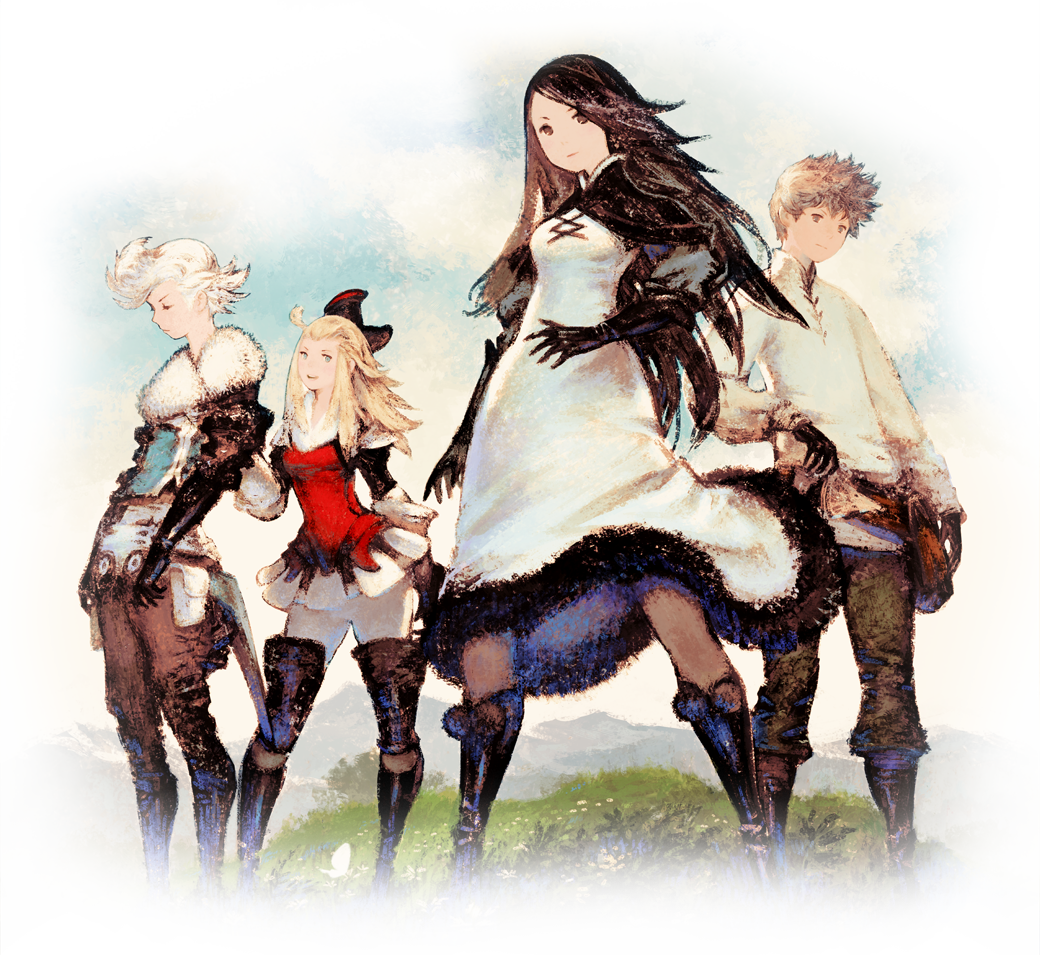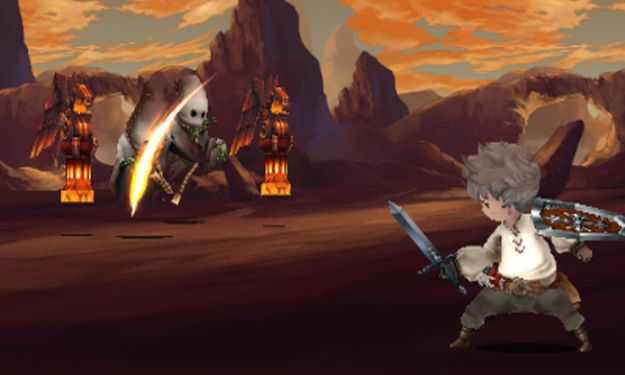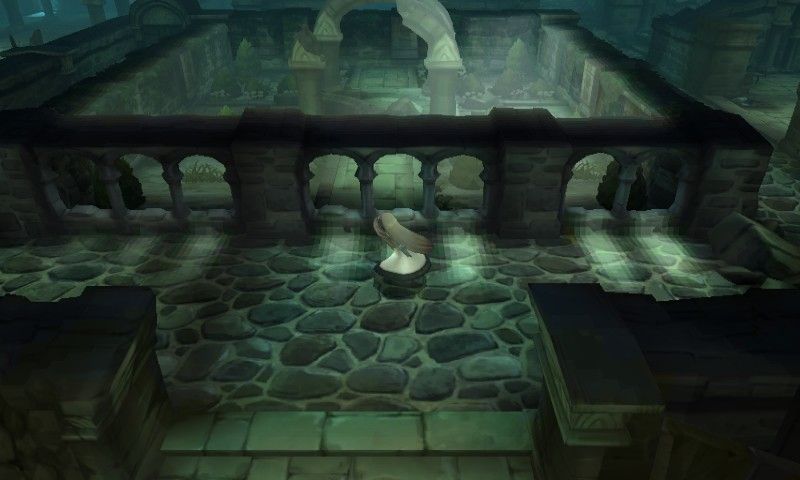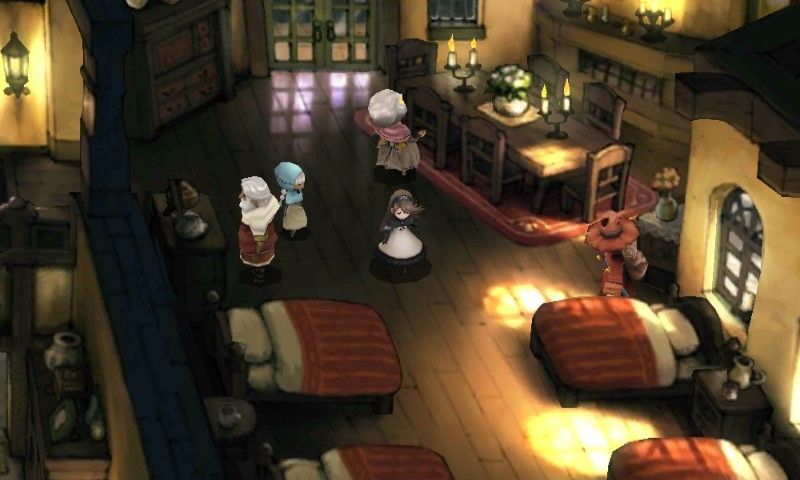(Credit to NeoGAF's Bravely Default thread for the great title.)
There are plenty of people that believe the turn-based JRPG to be an "ancient relic" that has become obsolete in the face of more modern, action-oriented battle systems.
However, games like Persona 4, Shin Megami Tensei IV and now Bravely Default have proven the notion to be lacking and downright deceptive.
Bravely Default is one of those rare gems that blends old and new with incredible skill and finesse. The turn-based and more strategy-oriented combat system, along with the simpler plot and charming characters and setting, harken to the golden age of JRPGs. However, this is a game that doesn't just upgrade those classic features but instead turns them on their head.
A great example is random encounters. Yes, Bravely Default has random encounters and no, they are neither annoying nor intrusive. The normal encounter rate is surprisingly fair and leaves the player ample time to explore without being interrupted. But what sets this game apart is the fact that you can completely control the rate--either by dialing it up for grinding purposes or turning it off completely. Of course if you prefer, leaving it alone entirely for authenticity's sake is an option as well. This level of control is beyond even what action-JRPGs can pull off and is an excellent indicator of how old can be turned into new without sacrificing either.
Speaking of encounter rates, the title's prized jewel--the Brave or Default system--adds even more variety and customization to battles. Basically, party members each have something called Brave Points that allow them to act. When the counter is at 0 or higher, that character can act by choosing from several commands. You can also either Default to stock up on BP or stack turns with Brave. While you can "borrow" BP to gain extra turns with Brave, you can't act when it's in the negatives.
The system works incredibly well and allows players to choose their preferred playstyle--going the steady and safe route by stacking turns and constantly being able to act or risking your defense and initiating an all-out attack on the enemy. Both methods are equally viable.
Another old-fashioned but still relevant feature is the standard job class system. Characters can switch between several different jobs, each with with different stats and abilities, by using an item called an Asterisk. This unique item contains the essence of that job and can be gained either through the main story or through special side quests that pop up throughout the game to supplement the main plot.
Switching between classes is fun and easy, and class skills can be mixed and matched to create many combinations (such as having a Monk with White Mage skills to be able to self-heal in battle). Learning the skills themselves has also been more streamlined; instead of having to manually use Job Points (JP) to learn skills, the character learns them automatically just by being in that class.
A nifty little feature that can turn the tide in battle is the Special Attack. Unlike in most JRPGs, Bravely Default's specials are based on weapons and are not unique to the character, which adds to the customization options. You can change the name, the effect(s) of the move and even what the characters say while performing it.
What I enjoyed about combat as well are the Spotpass and Friends List features. For instance, when you register friends or Spotpass players that have Bravely Default, you can summon them into battle to perform whatever special move (be it physical attack, offensive magic, healing, support magic, etc.) they registered on their profile. In turn players can also register their own special move for the same purposes. If a player doesn't have a friend, they need not worry as the game will provide them with a handy Friend-bot, whose data even updates everyday for the most optimum attack.
For those who need extra help in the game, there are Sleep Points (SP). When using SP during battle, it stops time and BP is no longer used--instead SP is consumed, which essentially gives the party free turns. Players can either stock SP by keeping the game on but the 3DS in sleep mode, or by purchasing SP Drinks using real money.
Yes, the dreaded micro-transaction is in this game. Fear not because believe me when I say that it has absolutely no bearing on gameplay if you choose not to use them. In fact, the entire game can be played without using SP once, which is exactly how I played. Still, just the fact that micro-transactions are even in the game in the first place is disconcerning.
Stemming from that, the dungeons in Bravely Default vary in size and design while maintaining a certain familiarity. What I enjoy the most about each one is the length--long enough to feel like a winding maze but never overstaying its welcome.
There's also another benefit to Spotpass--the rebuilding of Norende village. Norende village needs to be restored to its former glory and only the player can see that done. But first, villagers are needed to help repair shops and get rid of obstacles. Did you play the demo? If yes, you can transfer up to 20 villagers from the demo to form a handy workforce. If no, then you'll have to start from scratch and gather villagers from Spotpass and/or by updating data using an internet connection.
This super mini-game makes for a great addition to the main game, as it's both fun and beneficial to the game. That adventure who somehow appears in every town and dungeon? The items, weapons and equipment he sells are directly related to the shops you repair, and it's a huge help to have an excellent selection of wares in dungeons for emergency healing and upgrades. Plus rebuilding village is the only way to obtain additional Special move parts.
Moving along, the story starts off a little slow but then picks up momentum by the second chapter. It's more character and politically-driven since many of the developers behind this game worked on the Ivalice series, which is what I prefer to see in a plot. There are also plenty of very dark undertones throughout the story, and it's incredibly refreshing to see a JRPG balance light and dark themes so well.
The best part about the story personally would be the Party Chats. Party Chat is a nifty feature that crops up pretty often and with the push of a button allows players to listen in on various conversations, whether they relate to the plot or not. It's similar to the system in the Tales of series and gives the player insight into group dynamics.
I absolutely adore this feature and believe the writing to be at its pinnacle in cleverness and hilarity. If only a bit of that essence could be transferred over to the main story's writing, then it would be almost perfect.
Graphically, Bravely Default is gorgeous. The hand-drawn backgrounds and environments are simply stunning, blending in perfectly with the cutesy character models and giving the title that old-time feel of a bygone era. The camera even knows this and will actually pan back after a moment of idleness to give players the best view of all the scenery porn.
If the graphics are amazing, then the music is near flawless. I couldn't write enough praises about the sheer majesty of this game's soundtrack. Every piece of music, from town themes to battle themes to dungeon music to even menu tunes, is stunning. The composer has really outdone himself this time.
As for the negatives, gameplay-wise there really aren't any major issues. The battle and class systems are smooth and well-balanced, the story is intriguing and the music and graphics are on point. The developments teams really outdid themselves in creating a top-notch experience.
While it may not appeal to every RPG fan, Bravely Default proves that older mechanics aren't obsolete--it has a place in modern times among those that prefer a little nostalgia in their gaming. "Different strokes for different folks" they say and this stroke is nothing short of grand.
Bravely Default
- Platform(s)
- 3DS
- Released
- February 7, 2014
- Developer(s)
- Silicon Studio
- Publisher(s)
- Nintendo , Square Enix
- Genre(s)
- JRPG
- ESRB
- T For Teen due to Fantasy Violence, Mild Blood, Mild Suggestive Themes, Use of Alcohol
- How Long To Beat
- 60 Hours





